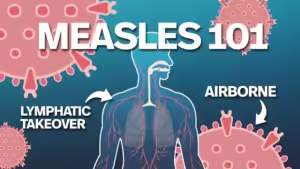A sharp rise in measles cases across Canada has sparked growing concerns among health officials, particularly as the virus spreads rapidly in Ontario. Despite efforts to contain outbreaks, new cases continue to emerge nationwide.
The Outbreak’s Origins and Spread
Canada’s current measles outbreak began in October, when an infected traveler introduced the virus to New Brunswick. Although the province officially declared the outbreak over in January, cases have continued to rise in Ontario and other regions.
The situation is particularly worrying as unvaccinated individuals travel to and from high-risk areas—especially during peak travel periods like spring break. Infectious disease experts caution that those returning from measles hotspots, such as the southern United States, may unknowingly introduce the virus into their communities.
Dr. Brian Conway, an infectious disease specialist, emphasizes the highly contagious nature of measles. “Even a single case in a public setting can lead to widespread transmission if people are not vaccinated,” he warns.
According to the Public Health Agency of Canada (PHAC), 369 cases had been reported nationwide as of March 18. However, officials note that case numbers are changing constantly, sometimes by the hour, as local health authorities confirm new infections.
Why Measles Is Spreading So Quickly
Measles is among the most infectious diseases known, spreading far more easily than illnesses like COVID-19 or influenza. A key factor driving this outbreak is the decline in vaccination rates. PHAC data shows that nearly 80 percent of recent measles cases in Canada have been among unvaccinated individuals.
Christine Navarro, a public health physician in Ontario, describes the current situation as unprecedented. “We haven’t seen this level of measles transmission since before the disease was declared eliminated in Canada in 1998,” she says.
The virus has now been confirmed in British Columbia, Alberta, Saskatchewan, Manitoba, Ontario, and Quebec. Some cases stem from the initial New Brunswick outbreak, while others are linked to international travel.
Health Risks and Prevention Measures
Measles often starts with fever, cough, and red, watery eyes, followed by a distinctive red rash that spreads across the body. While most people recover, complications can be severe—especially for infants, pregnant individuals, and those with weakened immune systems. In some cases, measles can lead to pneumonia, brain inflammation, or even death.
Health experts are urging Canadians to check their vaccination status and ensure they are protected. The measles-mumps-rubella (MMR) vaccine is widely available and highly effective, with a two-dose regimen providing near-total immunity.
“If symptoms appear, people should seek medical care immediately,” advises PHAC’s Kerry Robinson. “But they should call ahead to ensure proper precautions are in place at healthcare facilities.”
Looking Ahead
Public health officials are closely monitoring the outbreak and working to contain further spread. However, with travel-related infections playing a major role in transmission, experts stress that vaccination remains the best defense against measles.
As the outbreak continues to evolve, officials warn that more cases are expected in the coming weeks—especially as Canadians return home from spring travel. The key to stopping measles, they emphasize, is ensuring as many people as possible are immunized.











































